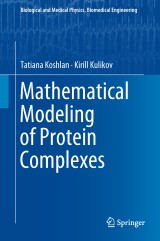Details

Mathematical Modeling of Protein Complexes
Biological and Medical Physics, Biomedical Engineering
|
96,29 € |
|
| Verlag: | Springer |
| Format: | |
| Veröffentl.: | 24.08.2018 |
| ISBN/EAN: | 9783319983042 |
| Sprache: | englisch |
Dieses eBook enthält ein Wasserzeichen.
Beschreibungen
<p>This book is devoted to the physical and mathematical modeling of the formation of complexes of protein molecules. The models developed show remarkable sensitivity to the amino acid sequences of proteins, which facilitates experimental studies and allows one to reduce the associated costs by reducing the number of measurements required according to the developed criteria. These models make it possible to reach a conclusion about the interactions between different amino acid chains and to identify more stable sites on proteins. The models also take the phosphorylation of amino acid residues into account.<br> At the end of the book, the authors present possible directions of application of their physical and mathematical models in clinical medicine.</p><p> <br> </p>
Introduction.- Physical methods for studying proteins.- Physical properties of amino acids and proteins.- Selection of a biological objects.- Mathematical simulation of complex formation of protein molecules allowing for their domain structure.- Mathematical modeling of histone dimers formation in vitro with solutions of different ionic strength in the presence of monovalent salts.- Mathematical modeling of the temperature effect on binding of monomeric proteins in aqueous solutions by example on histones H2A, H2B, H3 and H4.- Mathematical modeling of the temperature effect on binding of different sites of protein BCL-XL in aqueous solutions.- Mathematical modeling of the phosphorylation effect on the nature formation of biological complexes P53-MDM2 and P53-P300.
Tatiana Koshlan graduated from St. Petersburg State University, the department of Molecular Biophysics and Physics of Polymers. She is Master of Science in the field of biophysics. Now she is a post-graduate student at the department of Photonics, St. Petersburg State University. Her interdisciplinary research is in the field of biological and physical sciences. Her research is devoted to studying the interaction of biological molecules by physical methods, using mathematical tools to develop new technology and software with the ability to perform systematic measurements of various data sets of biological interactions. <p>Kirill Kulikov has been a full professor since 2014 at<b> Peter the Great St. Petersburg Polytechnical University,</b> Institute of Applied Mathematics and Mechanics, Department of Higher Mathematics. He received his Ph.D. in Physics and Mathematics with «Mathematical Modeling of the Optical Properties of Multilayer Biological Systems and Structures in their Heterogeneous Conjugation» (2004). He has habilitation at the<b> State Polytechnical University (Great St. Petersburg Polytechnical University) of St. Petersburg</b>, Russia (Doctor Science in Physics and Mathematics). His Doctor of Science thesis title was «Analytical models of interaction of laser radiation with complex heterogeneous biological tissues» (2014). His research interests are theory diffraction theory, electrodynamics, physics of lasers, tissue optical methods of mathematical modeling in biological tissue optics and numerical method, biophysics. <br></p>
<p>This book is devoted to the physical and mathematical modeling of the formation of complexes of protein molecules. The models developed show remarkable sensitivity to the amino acid sequences of proteins, which facilitates experimental studies and allows one to reduce the associated costs by reducing the number of measurements required according to the developed criteria. These models make it possible to reach a conclusion about the interactions between different amino acid chains and to identify more stable sites on proteins. The models also take the phosphorylation of amino acid residues into account.<br>At the end of the book, the authors present possible directions of application of their physical and mathematical models in clinical medicine.<br> </p>
Applies computational methods to simulate the electrostatic interaction of protein molecules to form complexes and domains Predicts amino acid sequences with specific physical properties Helps to improve the efficiency of experiments
Diese Produkte könnten Sie auch interessieren:

Alzheimer's Disease: Cellular and Molecular Aspects of Amyloid beta

von: J. Robin Harris, Falk Fahrenholz

213,99 €















